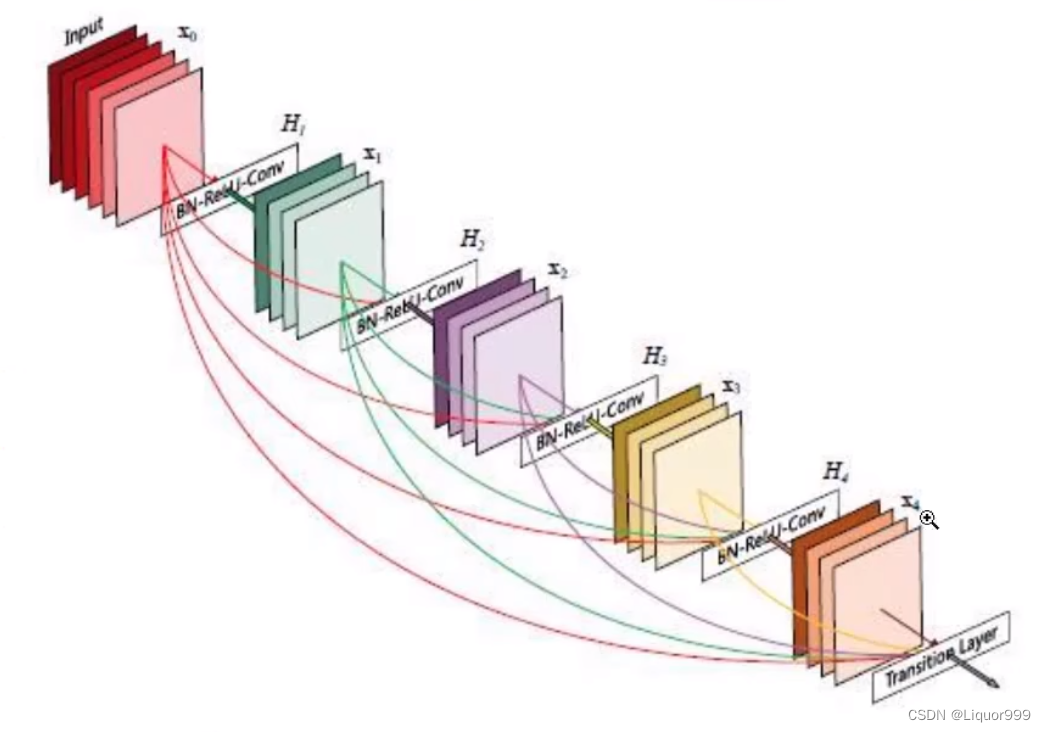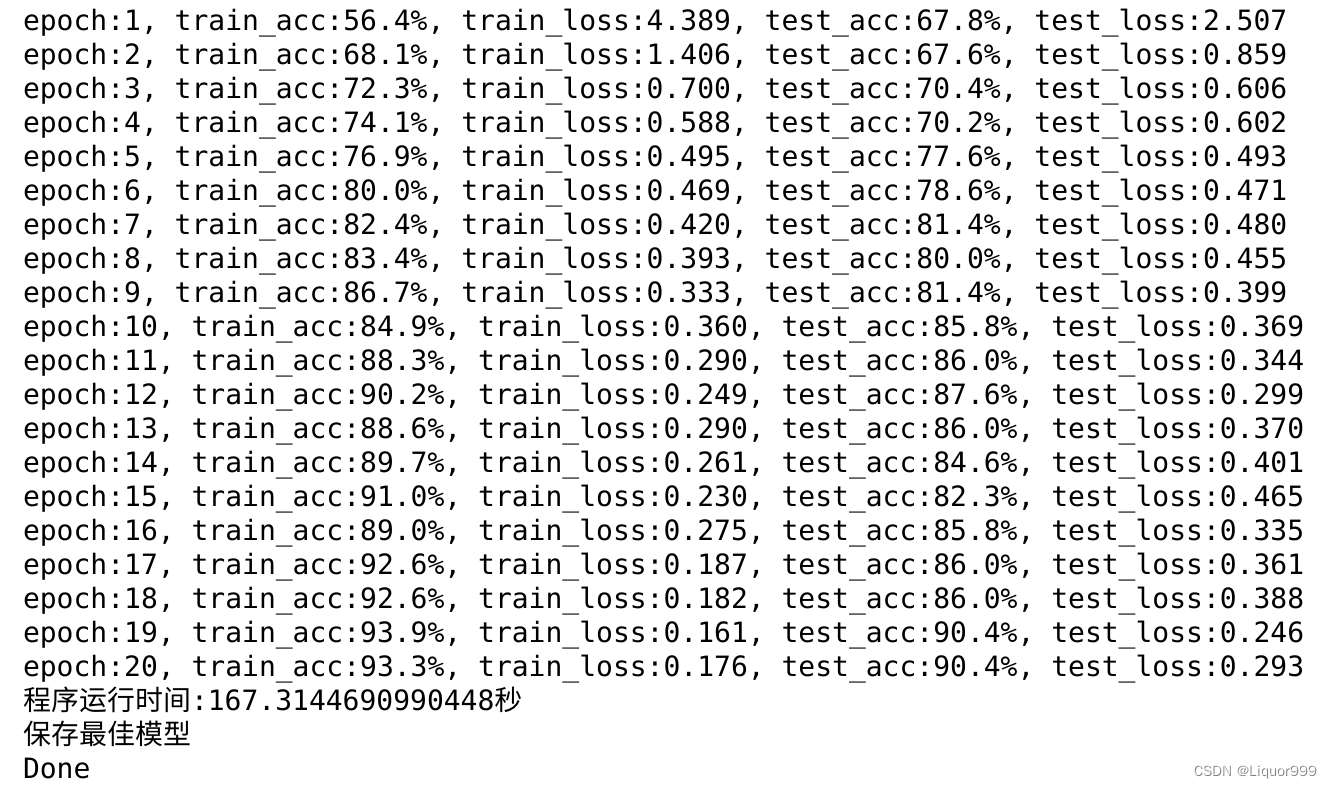Pytorch从零开始实战——DenseNet + SENet算法实战
本系列来源于365天深度学习训练营
原作者K同学
文章目录
- Pytorch从零开始实战——DenseNet + SENet算法实战
- 环境准备
- 数据集
- 模型选择
- 开始训练
- 可视化
- 总结
环境准备
本文基于Jupyter notebook,使用Python3.8,Pytorch2.0.1+cu118,torchvision0.15.2,需读者自行配置好环境且有一些深度学习理论基础。本次实验的目的是使用DenseNet+SENet模型。
第一步,导入常用包
import torch
import torch.nn as nn
import matplotlib.pyplot as plt
import torchvision
import torchvision.transforms as transforms
import torchvision.datasets as datasets
import torch.nn.functional as F
import random
from time import time
import numpy as np
import pandas as pd
import datetime
import gc
import os
import copy
import warnings
os.environ['KMP_DUPLICATE_LIB_OK']='True' # 用于避免jupyter环境突然关闭
torch.backends.cudnn.benchmark=True # 用于加速GPU运算的代码
设置随机数种子
torch.manual_seed(428)
torch.cuda.manual_seed(428)
torch.cuda.manual_seed_all(428)
random.seed(428)
np.random.seed(428)
检查设备对象
torch.manual_seed(428)
torch.cuda.manual_seed(428)
torch.cuda.manual_seed_all(428)
random.seed(428)
np.random.seed(428)
检查设备对象
device = torch.device("cuda" if torch.cuda.is_available() else "cpu")
device, torch.cuda.device_count() # # (device(type='cuda'), 2)
数据集
本次实验继续使用猴痘病数据集,使用pathlib查看类别,本次类别只有0,1两种类别分别代表患病和不患病。
import pathlib
data_dir = './data/ill/'
data_dir = pathlib.Path(data_dir) # 转成pathlib.Path对象
data_paths = list(data_dir.glob('*'))
classNames = [str(path).split("/")[2] for path in data_paths]
classNames # ['Monkeypox', 'Others']
使用transforms对数据集进行统一处理,并且根据文件夹名映射对应标签
all_transforms = transforms.Compose([transforms.Resize([224, 224]),transforms.ToTensor(),transforms.Normalize(mean=[0.485, 0.456, 0.406], std=[0.229, 0.224, 0.225]) # 标准化
])total_data = datasets.ImageFolder("./data/ill/", transform=all_transforms)
total_data.class_to_idx # {'Monkeypox': 0, 'Others': 1}
随机查看5张图片
def plotsample(data):fig, axs = plt.subplots(1, 5, figsize=(10, 10)) #建立子图for i in range(5):num = random.randint(0, len(data) - 1) #首先选取随机数,随机选取五次#抽取数据中对应的图像对象,make_grid函数可将任意格式的图像的通道数升为3,而不改变图像原始的数据#而展示图像用的imshow函数最常见的输入格式也是3通道npimg = torchvision.utils.make_grid(data[num][0]).numpy()nplabel = data[num][1] #提取标签 #将图像由(3, weight, height)转化为(weight, height, 3),并放入imshow函数中读取axs[i].imshow(np.transpose(npimg, (1, 2, 0))) axs[i].set_title(nplabel) #给每个子图加上标签axs[i].axis("off") #消除每个子图的坐标轴plotsample(total_data)

根据8比2划分数据集和测试集,并且利用DataLoader划分批次和随机打乱
train_size = int(0.8 * len(total_data))
test_size = len(total_data) - train_size
train_ds, test_ds = torch.utils.data.random_split(total_data, [train_size, test_size])batch_size = 32
train_dl = torch.utils.data.DataLoader(train_ds,batch_size=batch_size,shuffle=True,)
test_dl = torch.utils.data.DataLoader(test_ds,batch_size=batch_size,shuffle=True,)len(train_dl.dataset), len(test_dl.dataset) # (1713, 429)
模型选择
本次实验使用DenseNet + SENet模型,DenseNet的设计核心思想是通过密集连接来增强神经网络的信息流动,促进梯度的传播,以及提高参数的共享和重复使用。采用跨通道concat的形式来连接,会连接前面所有层作为输入。
核心公式为:

DenseNet中的基本组成单元是DenseBlock,它由多个密集连接的DenseLayer组成。每个DenseLayer都接收所有前面的DenseLayer特征作为输入,将其连接到自己的输出上,并传递给后续的层。如图所示,这是一个基本的DenseBlock模块。

整体网络架构图如下所示,借用K同学的图片

为了控制模型的复杂度并减少特征图的大小,DenseNet引入了Transition Block。过渡块包括批归一化、ReLU激活和 1x1 卷积,以减小特征图的通道数,并通过池化操作降低空间维度。

首先对DenseLayer类定义,本次实验使用add_module函数,默认是用于向类中添加一个子模块,第一个参数为模块名,第二个参数为模块实例,其实相当于加到父类的nn.Sequential里面,所以调用的时候使用super().forward(x),这段的核心是将输入 x 与新特征 t 进行通道维度上的连接,完成密集连接。
class DenseLayer(nn.Sequential):def __init__(self, num_input_features, growth_rate, bn_size, drop_rate):super().__init__()self.add_module("norm1", nn.BatchNorm2d(num_input_features))self.add_module("relu1", nn.ReLU(inplace=True))self.add_module("conv1", nn.Conv2d(num_input_features, bn_size * growth_rate, kernel_size=1, stride=1, bias=False))self.add_module("norm2", nn.BatchNorm2d(bn_size * growth_rate))self.add_module("relu2", nn.ReLU(inplace=True))self.add_module("conv2", nn.Conv2d(bn_size*growth_rate, growth_rate, kernel_size=3, stride=1, padding=1, bias=False))self.drop_rate = drop_ratedef forward(self, x):t = super().forward(x)if self.drop_rate > 0:t = F.dropout(t, p=self.drop_rate, training=self.training)return torch.cat([x, t], 1)
下面是DenseBlock的实现,通过循环创建了多个DenseLayer。其中的 num_input_features + i * growth_rate 用于指定输入通道的数量,确保每个DenseLayer的输入通道数逐渐增加。将新创建的DenseLayer添加为 DenseBlock 的子模块。循环结束后,DenseBlock 就包含了多个DenseLayer,每个DenseLayer都具有逐渐增加的输入通道数量。
class DenseBlock(nn.Sequential):def __init__(self, num_layers, num_input_features, bn_size, growth_rate, drop_rate):super().__init__()for i in range(num_layers):layer = DenseLayer(num_input_features + i * growth_rate, growth_rate, bn_size, drop_rate)self.add_module("denselayer%d" % (i + 1), layer)
下面是Transition,实现过渡的功能,是在块之间降低通道数量和空间维度。
class Transition(nn.Sequential):def __init__(self, num_input_feature, num_output_features):super().__init__()self.add_module("norm", nn.BatchNorm2d(num_input_feature))self.add_module("relu", nn.ReLU(inplace=True))self.add_module("conv", nn.Conv2d(num_input_feature, num_output_features, kernel_size=1, stride=1, bias=False))self.add_module("pool", nn.AvgPool2d(2, stride=2))
SENet是一种深度神经网络结构,它的核心思想是允许网络在训练期间对每个通道进行自适应的加权,以使网络能够更加关注对任务有用的通道,并抑制对任务无关的通道。这有助于提高网络对输入数据的敏感性,并提升网络性能。SENet的结构包括两个主要组件:Squeeze 操作和 Excitation 操作。
Squeeze 操作(Global Average Pooling):通过全局平均池化,将每个通道的空间维度降为1。这样,对于每个通道,都得到一个单一的数值,反映了该通道对整个特征图的重要性。
Excitation 操作(通道注意力):在 Squeeze 操作后,通过一个小型的多层感知机(MLP)来学习通道之间的关系。这个小型MLP包含一个压缩操作和一个激励操作)。最后,利用学到的权重对每个通道的特征图进行加权,得到加权后的特征表示。

下面是SENet的实现,首先,通过全局平均池化层对输入特征图进行平均池化,将每个通道的空间维度降为1。然后,通过全连接层序列 fc 对降维后的特征进行处理,得到每个通道的注意力权重。最后,将得到的注意力权重通过 view 操作还原为与输入特征图相同的形状,并将其与输入特征图相乘,得到应用了注意力机制的特征图。
from torch.nn import init
class SEAttention(nn.Module):def __init__(self, channel=512, reduction=16):super().__init__()self.avg_pool = nn.AdaptiveAvgPool2d(1)self.fc = nn.Sequential(nn.Linear(channel, channel // reduction, bias=False),nn.ReLU(inplace=True),nn.Linear(channel // reduction, channel, bias=False),nn.Sigmoid())def init_weights(self):for m in self.modules():if isinstance(m, nn.Conv2d):init.kaiming_normal_(m.weight, mode='fan_out')if m.bias is not None:init.constant_(m.bias, 0)elif isinstance(m, nn.BatchNorm2d):init.constant_(m.weight, 1)init.constant_(m.bias, 0)elif isinstance(m, nn.Linear):init.normal_(m.weight, std=0.001)if m.bias is not None:init.constant_(m.bias, 0)def forward(self, x):b, c, _, _ = x.size()y = self.avg_pool(x).view(b, c)y = self.fc(y).view(b, c, 1, 1)return x * y.expand_as(x)
整体模型实现,self.features 是一个包含多个层的序列,包括初始卷积块、多个DenseBlock和Transition,以及最后的全局平均池化和分类器。遍历 block_config 中的配置,创建DenseBlock和Transition。参数初始化部分使用了 Kaiming 初始化和常数初始化。
其中,OrderedDict是Python中的一种有序字典数据结构,它保留了元素添加的顺序。在神经网络中,我们可以使用OrderedDict来指定模型的层次结构。
在进行平均池化之前,进入到SENet进行学习通道注意力权重从而提高网络的表征能力。
from collections import OrderedDictclass DenseNet(nn.Module):def __init__(self, growth_rate=32, block_config=(6, 12, 24, 16), num_init_features=64,bn_size=4, compression_rate=0.5, drop_rate=0, num_classes=1000):super().__init__()self.features = nn.Sequential(OrderedDict([("conv0", nn.Conv2d(3, num_init_features, kernel_size=7, stride=2, padding=3, bias=False)),("norm0", nn.BatchNorm2d(num_init_features)),("relu0", nn.ReLU(inplace=True)),("pool0", nn.MaxPool2d(3, stride=2, padding=1))]))num_features = num_init_featuresfor i, num_layers in enumerate(block_config):block = DenseBlock(num_layers, num_features, bn_size, growth_rate, drop_rate)self.features.add_module("denseblock%d" % (i + 1), block)num_features += num_layers * growth_rateif i != len(block_config) - 1:transition = Transition(num_features, int(num_features * compression_rate))self.features.add_module("transition%d" % (i + 1), transition)num_features = int(num_features * compression_rate)self.features.add_module("norm5", nn.BatchNorm2d(num_features))self.features.add_module("relu5", nn.ReLU(inplace=True))self.se = SEAttention(channel=1024, reduction=8)self.classifier = nn.Linear(num_features, num_classes)for m in self.modules():if isinstance(m, nn.Conv2d):nn.init.kaiming_normal_(m.weight)elif isinstance(m, nn.BatchNorm2d):nn.init.constant_(m.bias, 0)nn.init.constant_(m.weight, 1)elif isinstance(m, nn.Linear):if m.bias is not None:nn.init.constant_(m.bias, 0)def forward(self, x):features = self.features(x)out = self.se(features)out = F.avg_pool2d(features, 7, stride=1)out = out.view(features.size(0), -1)out = self.classifier(out)return out
使用summary查看网络
from torchsummary import summary
model = DenseNet().to(device)
summary(model, input_size=(3, 224, 224))

开始训练
定义训练函数
def train(dataloader, model, loss_fn, opt):size = len(dataloader.dataset)num_batches = len(dataloader)train_acc, train_loss = 0, 0for X, y in dataloader:X, y = X.to(device), y.to(device)pred = model(X)loss = loss_fn(pred, y)opt.zero_grad()loss.backward()opt.step()train_acc += (pred.argmax(1) == y).type(torch.float).sum().item()train_loss += loss.item()train_acc /= sizetrain_loss /= num_batchesreturn train_acc, train_loss
定义测试函数
def test(dataloader, model, loss_fn):size = len(dataloader.dataset)num_batches = len(dataloader)test_acc, test_loss = 0, 0with torch.no_grad():for X, y in dataloader:X, y = X.to(device), y.to(device)pred = model(X)loss = loss_fn(pred, y)test_acc += (pred.argmax(1) == y).type(torch.float).sum().item()test_loss += loss.item()test_acc /= sizetest_loss /= num_batchesreturn test_acc, test_loss
定义学习率、损失函数、优化算法
loss_fn = nn.CrossEntropyLoss()
learn_rate = 0.0001
opt = torch.optim.Adam(model.parameters(), lr=learn_rate)
开始训练,epoch设置为20
import time
epochs = 20
train_loss = []
train_acc = []
test_loss = []
test_acc = []T1 = time.time()best_acc = 0
best_model = 0for epoch in range(epochs):model.train()epoch_train_acc, epoch_train_loss = train(train_dl, model, loss_fn, opt)model.eval() # 确保模型不会进行训练操作epoch_test_acc, epoch_test_loss = test(test_dl, model, loss_fn)if epoch_test_acc > best_acc:best_acc = epoch_test_accbest_model = copy.deepcopy(model)train_acc.append(epoch_train_acc)train_loss.append(epoch_train_loss)test_acc.append(epoch_test_acc)test_loss.append(epoch_test_loss)print("epoch:%d, train_acc:%.1f%%, train_loss:%.3f, test_acc:%.1f%%, test_loss:%.3f"% (epoch + 1, epoch_train_acc * 100, epoch_train_loss, epoch_test_acc * 100, epoch_test_loss))T2 = time.time()
print('程序运行时间:%s秒' % (T2 - T1))PATH = './best_model.pth' # 保存的参数文件名
if best_model is not None:torch.save(best_model.state_dict(), PATH)print('保存最佳模型')
print("Done")

可视化
可视化训练过程与测试过程
import warnings
warnings.filterwarnings("ignore") #忽略警告信息
plt.rcParams['font.sans-serif'] = ['SimHei'] # 用来正常显示中文标签
plt.rcParams['axes.unicode_minus'] = False # 用来正常显示负号
plt.rcParams['figure.dpi'] = 100 #分辨率epochs_range = range(epochs)plt.figure(figsize=(12, 3))
plt.subplot(1, 2, 1)plt.plot(epochs_range, train_acc, label='Training Accuracy')
plt.plot(epochs_range, test_acc, label='Test Accuracy')
plt.legend(loc='lower right')
plt.title('Training and Validation Accuracy')plt.subplot(1, 2, 2)
plt.plot(epochs_range, train_loss, label='Training Loss')
plt.plot(epochs_range, test_loss, label='Test Loss')
plt.legend(loc='upper right')
plt.title('Training and Validation Loss')
plt.show()

总结
SE模块引入了通道注意力机制,使得网络在学习过程中能够更加自适应地关注对任务有用的通道,抑制对任务无关的通道。这有助于提高网络的特征表达能力。当前也可以与各种其他的深度神经网络结构集成。因此,可以在不改变整体网络架构的情况下,通过引入通道注意力机制来增强网络性能。












--任务)



生成(三维曲面地形图)和(圆柱曲面地形图))


